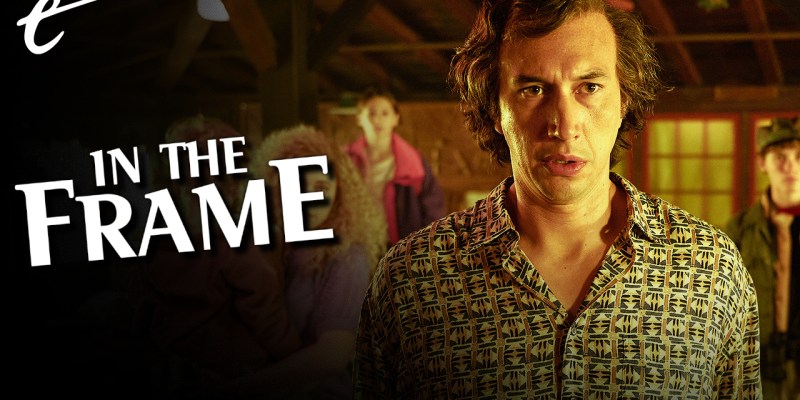This article contains some spoilers for White Noise, directed by Noah Baumbach and streaming now on Netflix, in its discussion of the human death drive.
White Noise opens with a lecture from Professor Murray Siskind (Don Cheadle), addressing both his students and the audience watching at home. “Roll film,” he begins as the movie roars to life. Director Noah Baumbach and editor Matthew Hannam then provide a montage of car crashes drawn from the history of American filmmaking. They are there in black and white, on celluloid, on digital. The entire cinematic medium is reduced to its most basic image: an object in motion.
Murray isn’t simply interested in motion. He’s fascinated by collision. However, he is careful not to frame the footage in morbid or macabre terms. “Don’t think of a car crash in a movie as a violent act,” he urges his students. “No, these collisions are part of a long tradition of American optimism.” Murray argues that these car crashes are an act of triumph. “Each crash is meant to be better than the last,” he explains. “There’s a constant upgrading of tools, skills, a meeting of challenges.”
White Noise cuts sharply from this lecture to its title card, which finds the movie’s title overlaid against an overhead shot of two lanes of traffic. These cars are not crashing into one another. They are barely moving. They are arranged neatly in lines, as parents drive their children up to the start of the college’s latest semester. It is all very ordered. Murray doesn’t seem particularly interested in this imagery, but his colleague Professor Jack Gladney (Adam Driver) is obsessed with it.
Jack rushes home to tell his wife Babette (Greta Gerwig) about this. She is disappointed that she missed it and that he did not remind her. Just as Murray finds optimism in the crashes, Jack sees something innocent in the ordered queues. “It’s the day of the station wagons,” he muses. “It was a brilliant event. They stretched all the way past the music library and onto the interstate.” There’s a permanence to the ritual. “I have trouble imagining death at that income level,” Babette confesses.
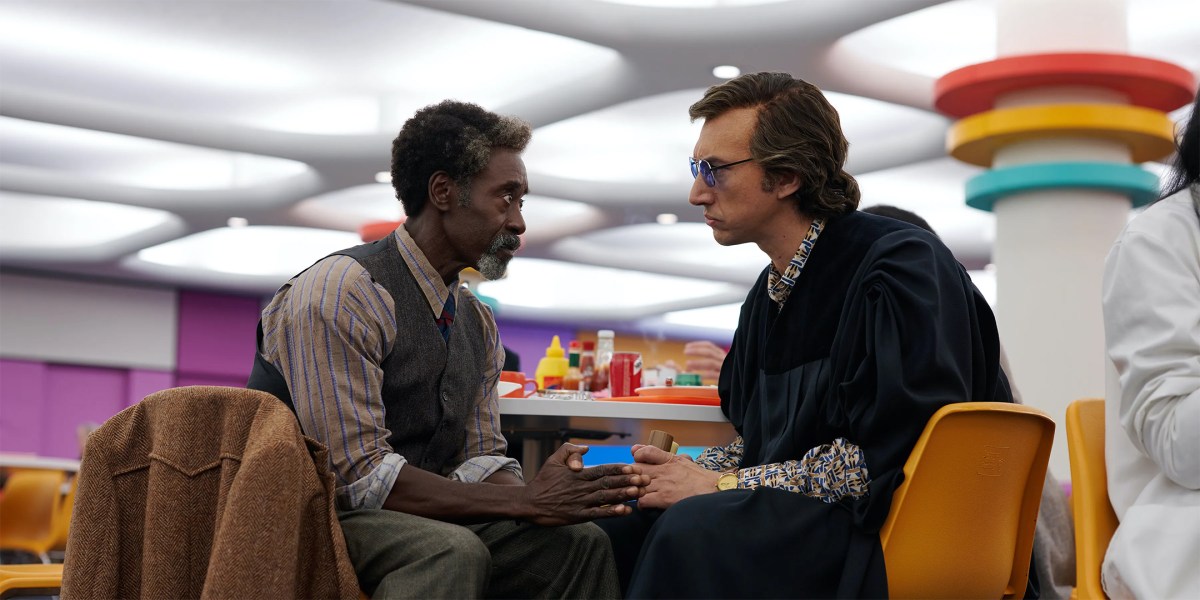
These two images set up the central thematic preoccupation of White Noise, an adaptation of Don DeLillo’s postmodern classic. DeLillo’s novel was first published in 1985 and quickly established itself as an important work of American fiction. It won the National Book Award for Fiction and made Time’s list of the best English-language novels between 1923 and 2005. It was, as coverage of Baumbach’s movie frequently notes, considered “unfilmable” and “impossible to adapt.”
White Noise is a dense text. It is immediately recognizable as a product of the Reagan era, with both Jack and Murray teaching at “the College on the Hill,” an allusion to Reagan’s “Shining City on a Hill.” It has been read in many different ways, as a critique of the “late-capitalist world of consumerism” and as a prime example of the “campus novel.” All of these elements are present in Baumbach’s adaptation, but he focuses on one theme in particular. At its core, White Noise is about death.
In particular, White Noise is a film about the things that people do in order to avoid thinking about death, at least consciously. In an academic sense, Jack is preoccupied with death. He boasts that he is a pioneer in the field of “Hitler Studies” or “Advanced Nazism.” He is internationally respected for his work in the field. The course, naturally, gravitates towards death. As Murray explains around the midpoint of the movie, “Some people are larger than life. Hitler is larger than death.”
Then again, Jack would argue that life itself gravitates towards death. Asked to discuss the 20 July plot to assassinate Hitler, Jack free-associates, “All plots move deathward. This is the nature of plots. Political plots, terrorists’ plots, lovers’ plots, narrative plots, plots that are a part of children’s games. We edge closer to death every time we plot.” This observation sounds profound, but it has very little to do specifically with Adolf Hitler and even less to do with an assassination attempt.
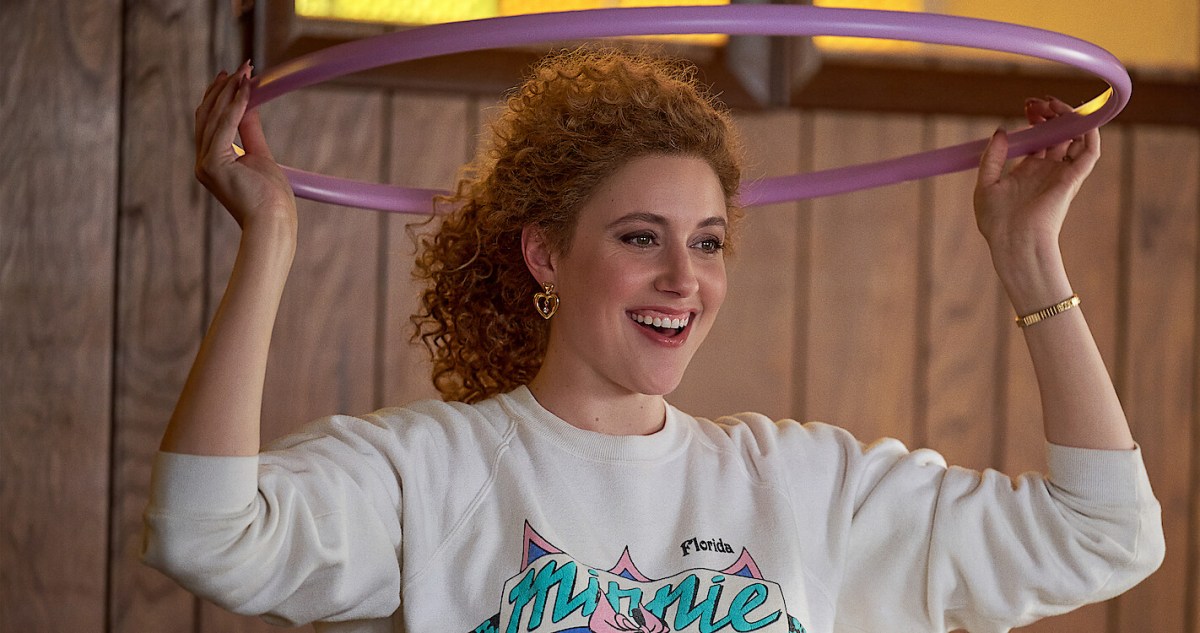
The irony is that this study seems to serve as a safe environment for Jack to articulate his preoccupation with mortality. Early in the movie, he and Babette argue over which of them should die first. Jack argues that he should die first because he cannot contemplate living without her love. Babette scolds him, “You don’t really want to die first. You don’t want to be alone, but you don’t want to die more than you don’t want to be alone.” Jack replies, “I hope we both live forever.”
Although Baumbach has established himself as a distinctive director in his own right, it is notable that he worked quite frequently with Wes Anderson early in his career. Baumbach is credited as co-writer with Anderson on both The Life Aquatic with Steve Zissou and Fantastic Mr. Fox. At times, White Noise feels somewhat adjacent to Anderson’s distinct aesthetic, particularly in Jess Gonchor’s production design, Ann Roth’s costume design, and Baumbach’s dialogue.
There is a very arch and surrealist quality to White Noise, in how the characters talk to one another about the situations in which they find themselves. However, as in the best work from Baumbach and Anderson, this heightened approach is grounded in a very real humanism. Early in the film, Jack observes that they are living what “sounds like a boring life.” Babette replies, “I hope it lasts forever.” The central tension of White Noise is built on the understanding that it cannot.
Despite the bright colors and the neon lights, death is everywhere in White Noise. Background televisions frequently play car chases and car crashes. Jack’s son Heinrich (Sam Nivola) rushes around the house to gather his siblings when the television news plays “plane crash footage.” Jack is clearly uncomfortable with this reminder of mortality. “Let’s watch a sitcom or something,” he offers, as if looking for anything to distract him from the inevitability of death.
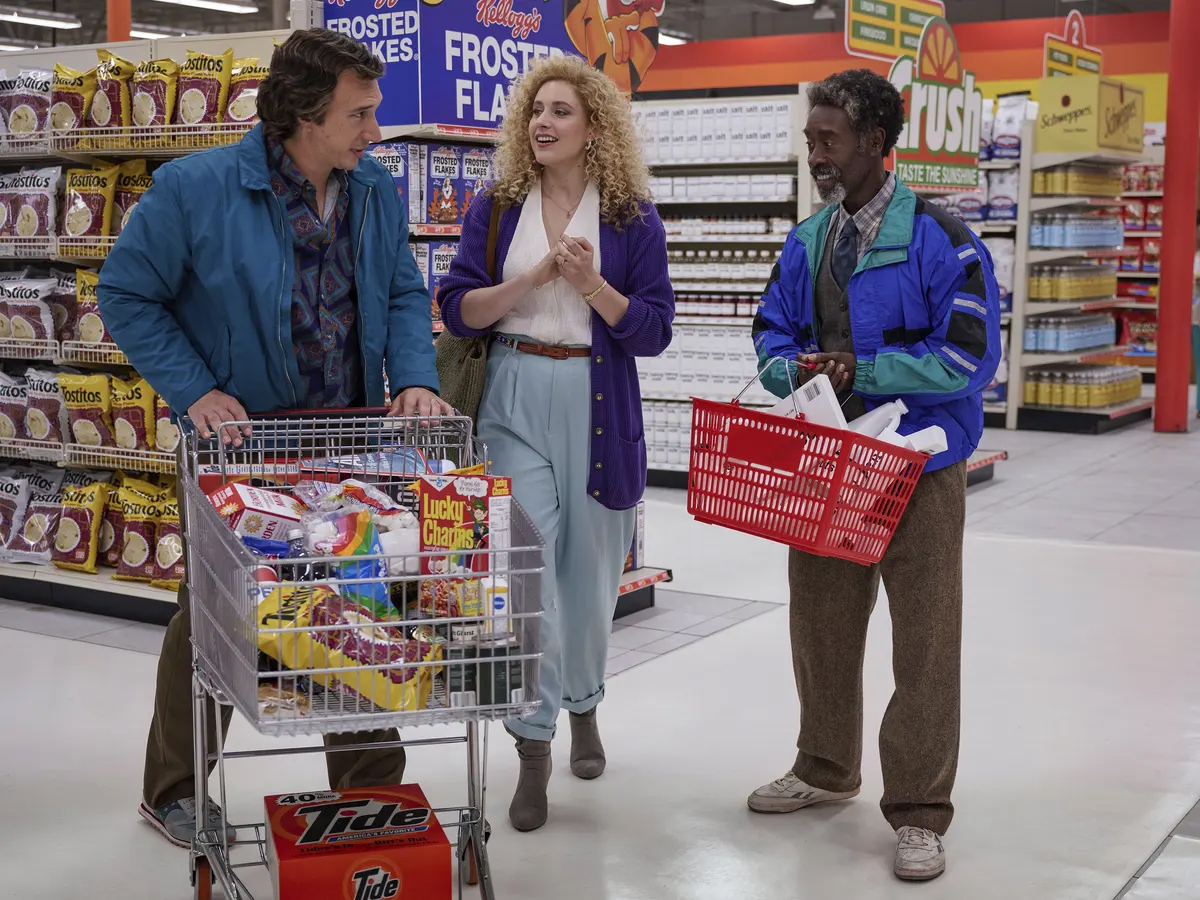
Lisa Piñero’s sound design in White Noise is impressive. Throughout the film, there are constant overlapping conversations. Televisions and radios play in the background. There is a constant hum of activity. It can be difficult to follow conversational threads. As with Everything Everywhere All at Once earlier in the year, there is a sense of information overload. However, there is something appealing in that overload because it provides a constant and welcome distraction.
“What if death is nothing but sound?” Jack muses to himself during one trip to the supermarket. “You hear it forever. Sound, all around.” White Noise is fascinated by how far people will go to drown out the noise of their own inevitable passing. Given how firmly the movie is rooted in the 1980s, it is no surprise that the three main avenues that people use to silence this inevitability are sex, media, and consumption.
The local supermarket becomes an almost religious space. Jack has some of his most profound conversations with Murray in the supermarket. At the end of the movie, the family reunited, they take a trip together to the store. Indeed, one of the more cynical touches in White Noise has Babette asking a group of nuns what they think heaven must be like, only for the nuns to completely reject the idea of spiritual belief. If one doesn’t believe in an afterlife, it’s best not to think about death.
The second act of White Noise is driven by “the Airborne Toxic Event,” a noxious cloud that is the result of a collision between a train and a lorry, both carrying dangerous chemicals. Again, this is firmly rooted in the news reports of the time. This cloud is a none-too-subtle metaphor for the very idea of death itself, with the collision cut against Jack lecturing on the subject. One observer (Bill Camp) describes the cloud as a “death ship” that “sailed across the sky.”
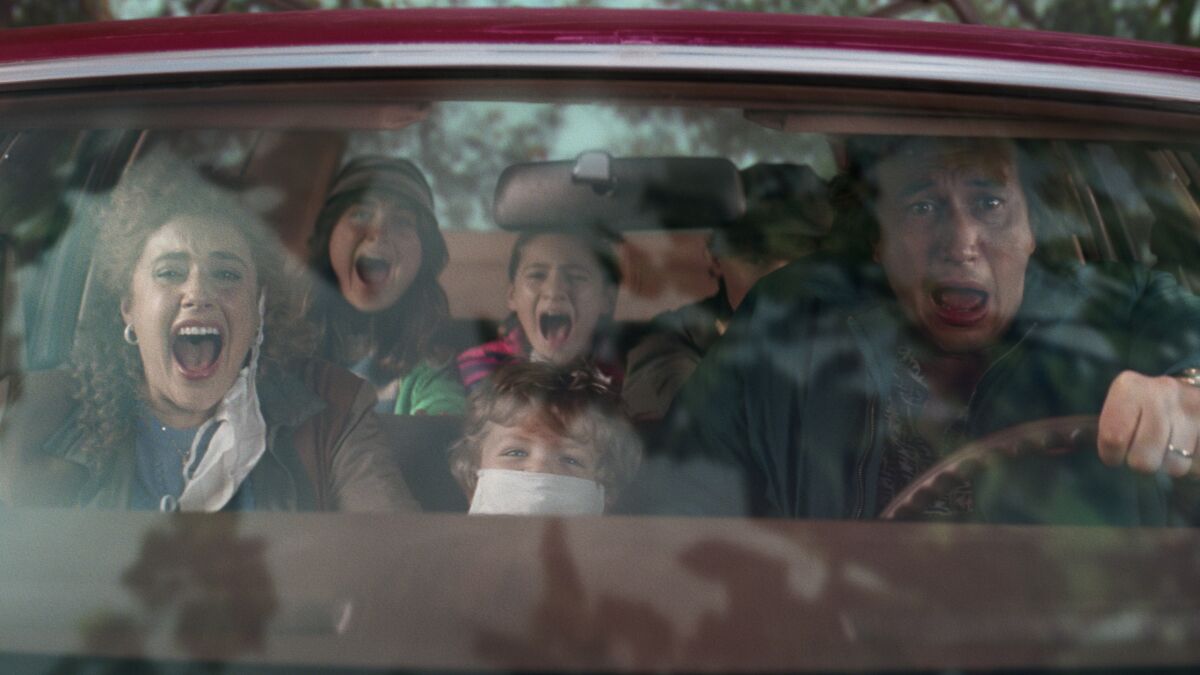
Jack treats the cloud the same way that he treats death. He chooses to ignore it. He insists that it cannot upset the family’s idyllic existence. “It won’t come this way,” he promises. “We don’t die. Not from this. All we have to do is stay out of the way.” As the shadow looms closer, Jack fidgets with Babette’s bra and wonders what she is cooking for dinner, as if trying to distract himself from even the remote possibility of facing his mortality.
“The Airborne Toxic Event” works as a metaphor for the necessity of confronting death and the chaos that can result from it. Jack and his family witness more than a few firsthand car crashes. When the car gets stuck in a river, Jack is frustrated by the idle bickering about unrelated subjects. “Doesn’t anyone want to pay attention to what’s actually happening?” he inquires. Given Jack’s own difficulty confronting reality, it’s an ironic assertion.
In the movie’s third act, Babette admits that she has been taking an experimental drug named “Dylar,” designed to help her cope with the fear of death. She was rejected from the trial and sexually blackmailed by an anonymous man known as “Mr. Gray” (Lars Eidinger) for the drug. This revelation drives Jack into a frenzy. He takes a gun that was gifted from Murray and drives to a confrontation with the stranger. It ends with Mr. Gray, Babette, and Jack all shot, but all survive.
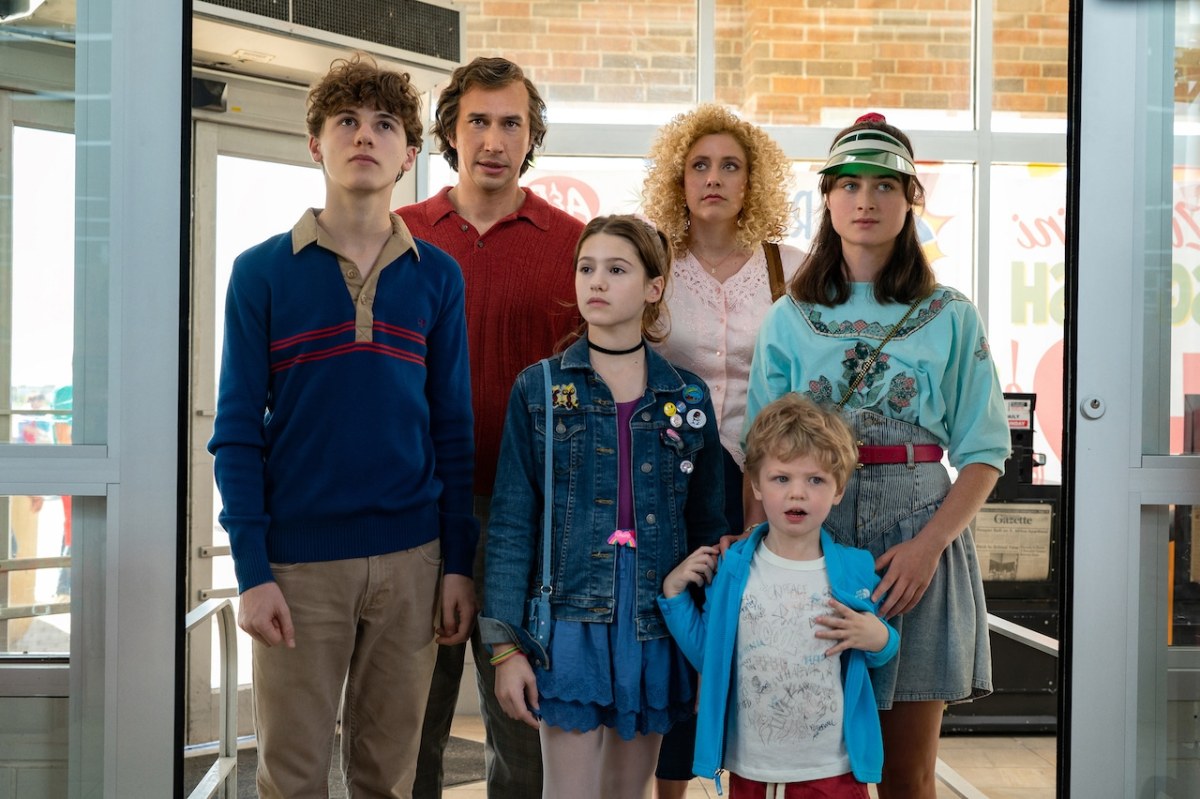
In a weird way, White Noise feels like a companion to another Netflix awards contender. Don’t Look Up was released on Christmas Day last year, and the streaming service’s star-studded satire became a surprise hit. Adam McKay’s movie was a none-too-subtle parable about climate change and mankind’s unwillingness to confront an actual extinction-level crisis. The movie was also incredibly blunt in its metaphor and broad in its commentary.
Don’t Look Up didn’t work because it was both too specific and too obvious. The movie was most interesting in the abstract, in its suggestion that maybe humankind is simply incapable of processing that sort of abstract existential threat. White Noise is a much shrewder and much more engaging interrogation of the same basic idea, the human fascination with death as spectacle and resistance to confronting it as a reality.
White Noise is a movie that works both as a timeless meditation on the human condition and as a timely story about the difficulty in even acknowledging any number of the looming extinction-level events lurking on the horizon. It’s about the human death drive, about life as either a car crash or a traffic jam. In either case, nobody’s getting anywhere.
